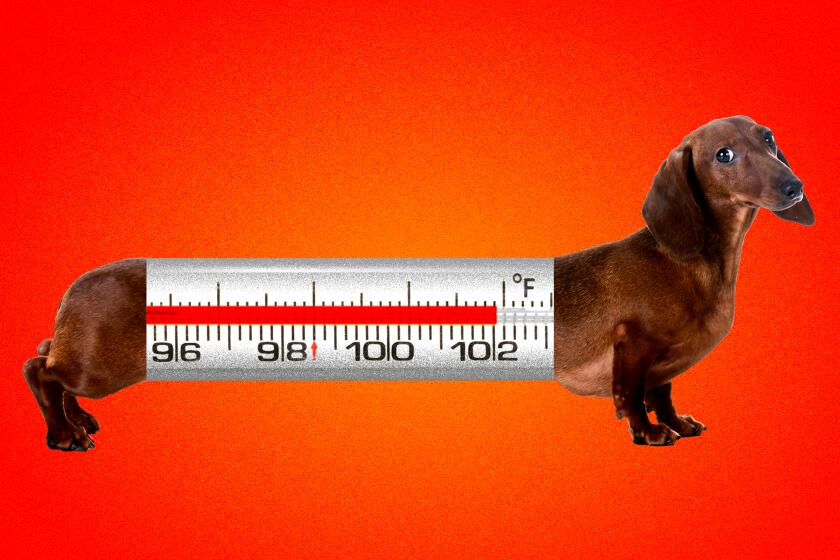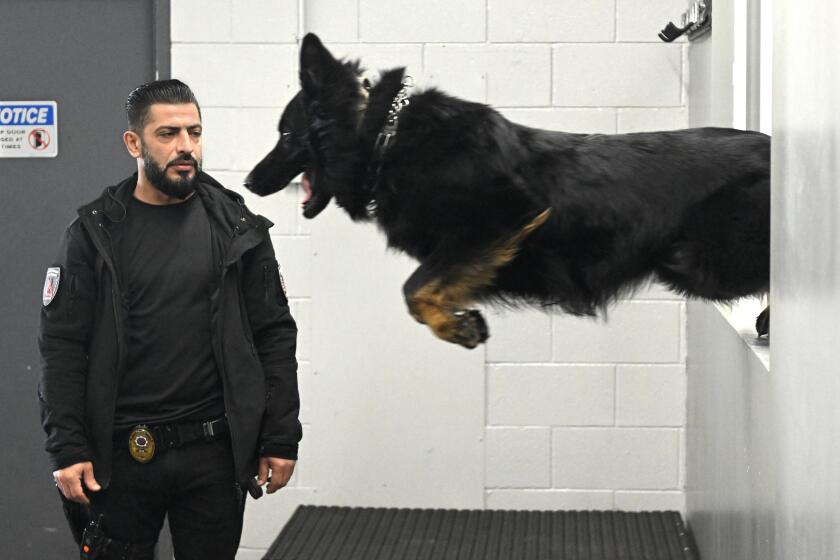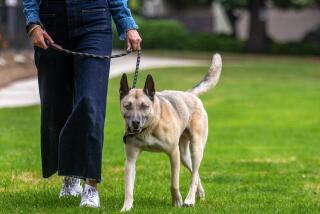How to protect your dog from its worst enemy: Fourth of July fireworks

Here it comes again, one of the most stressful days of the year for dogs and their owners.
And no, it’s not the annual trip to the vet. It’s Independence Day.
Known for extravagant official fireworks displays and abundant unofficial ones, this holiday poses a threat to animals around the nation — especially in Los Angeles and other big cities. As many dog owners know, our furry friends do not react well to patriotic outbursts in the form of random explosions that continue well into the night.
According to a Crosstown LA report, calls to the Los Angeles Police Department about fireworks spike each year on and around the Fourth. In recent years, Crosstown found, the volume skyrocketed each July from a few hundred calls to more than 2,000.
Dr. Meredith Kennedy, veterinarian and owner of Eagle Rock Animal Emergency, shared a list of tips and tricks to keep your dog safe this holiday weekend. Loud neighborhood Fourth of July fireworks displays are common in Eagle Rock, so Kennedy has seen it all.
Here’s a guide to places around Los Angeles where you can celebrate the nation’s 248th birthday with fireworks and festive light displays.
1. Should I confine my dog?
The safest place for a frightened pup is a small, secluded space. “It is very, very important that your dog be kept very strictly confined because dogs tend to get scared and they’ll jump fences, they’ll go blasting through open gates, they’ll dig out of the yards because they’re terrified and they don’t know what to do,” Kennedy said. Keeping them in your home or in a crate makes them feel safer.
2. Should I sedate my dog?
For the more reactive dogs, you can obtain a tranquilizer from your vet to keep them calm. Kennedy recommends acepromazine, dexmedetomidine and trazodone, which are all prescription medications. The time to get them, however, is now. Some of the more eager pyrotechnic connoisseurs set fireworks off during the entire week prior to the actual holiday. Kennedy says that dogs’ ears are much more sensitive than ours, and they can likely hear it all.
If you think it’s hot outside, then your pet is definitely feeling it. Here are tips on how to keep your furry friends cool in the heat.
3. Why is my dog sick?
If your dog starts to vomit and suffer from diarrhea in the next week or two, this may be a stress response. An overstimulated dog may have a physical response to its stressors. This could even result in bloody diarrhea. Another reason for these reactions may be that your dog is getting ahold of human food. This would also make it sick. So when you throw your parties, beware of food left within reach of your dog.
4. What if my dog gets too hot?
Something to watch out for — especially with short-faced breeds such as bulldogs and pugs — is overheating. “Unfortunately we lose a fair number of these dogs, even young in age, because they have overheated,” Kennedy says. If you have any sort of bulldog, her rule is: “No panting for more than 15 minutes.” If your dog exceeds this time limit, it may end up with swelling in the back of its throat and start to asphyxiate.
What should you do if your dog has been panting for too long? Move it to a cold room, confine it, put cold water on its legs and paws, set up a fan, put ice cubes in its water, and try to calm it down.
Are you and your pet prepared for earthquakes or other emergency evacuations?
5. What do I do if my dog gets hurt?
One common reason dogs are taken to the emergency room on the Fourth may surprise you. Many people put on events for their loved ones, and they sometimes bring their dogs. When there are multiple dogs in the same space and their stress levels are high, this combination, mixed with a lack of supervision, may lead to dog fights. Many of the dogs injured in fights haven’t gotten their rabies shots, so make sure your dog is up to date on its vaccinations.
To be on the safe side, check the hours that your preferred emergency vet will be open through the coming week.
Another regular occurrence on the Fourth is dogs escaping their homes. If your dog gets out, two resources are the websites for L.A. Animal Services and L.A. County Animal Care and Control. Check out their web pages for the steps you need to take to find your pet.
When a found dog is brought in to L.A. Animal Services, the first thing its staffers do is scan for microchips. If the dog has one, they will contact the owner’s phone number and send a letter to the address listed. The owner then has seven days to retrieve the dog; if it’s not claimed by then, it will be put up for adoption. Dogs without microchips have four days to be recovered.
There is a common misconception among dog lovers that the shelter will euthanize dogs that are brought to them. Animal Services says bringing a dog to a shelter is the best way to reunite it with its family. If you lose your dog, the first thing you should do is look at the shelter website to see if it has your dog.
6. How do I keep my cat safe?
You may be wondering: What about my cat? Many of the same rules apply. Keep them indoors and confined. Kennedy suggests putting them in a carrier and covering it with a blanket or towel. In other words, she says, “Make it look like a cave.”
A useful product to have on hand when caring for your agitated cat is a spray sold under the brand name Feliway that mimics the natural pheromones released by a mother cat to calm her kittens.
Cheaper than a bodyguard, more portable than an alarm system, guard dogs costing six figures are in high demand in L.A.’s wealthier precincts.
More to Read
Sign up for Essential California
The most important California stories and recommendations in your inbox every morning.
You may occasionally receive promotional content from the Los Angeles Times.














